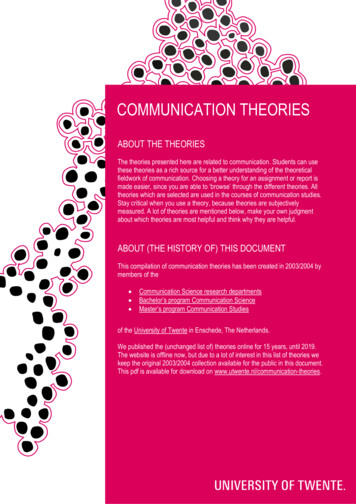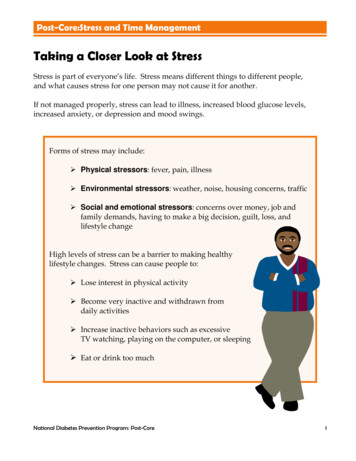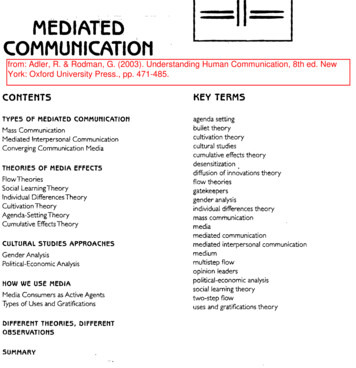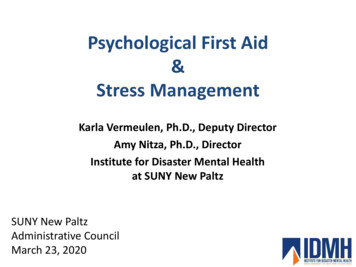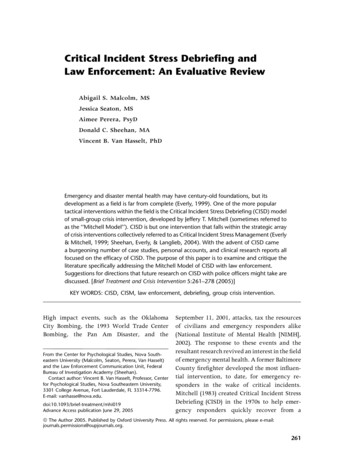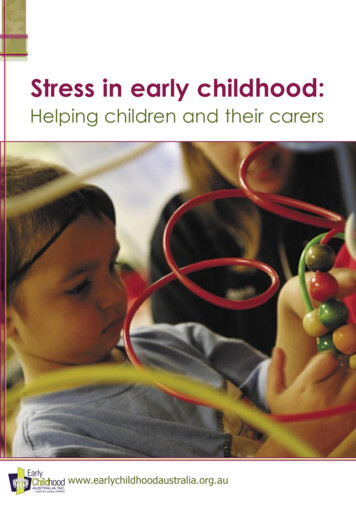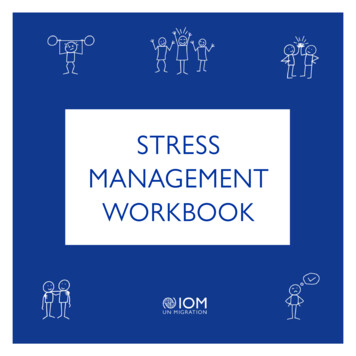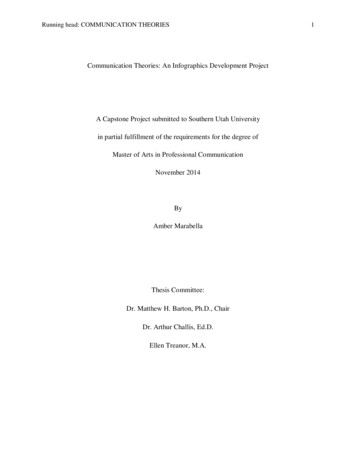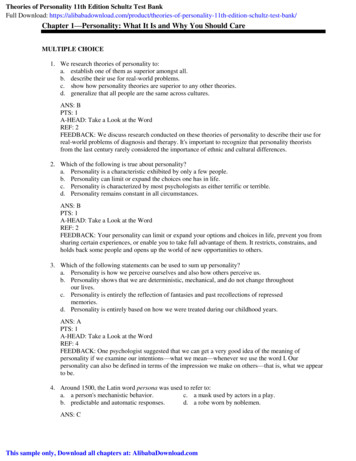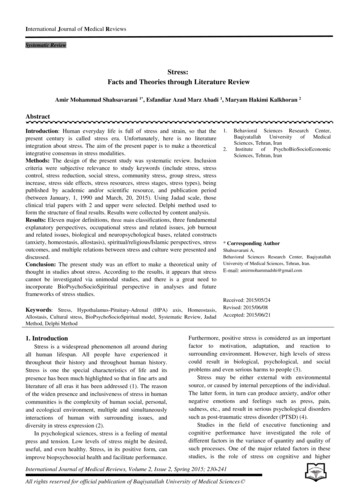
Transcription
International Journal of Medical ReviewsSystematic ReviewStress:Facts and Theories through Literature ReviewAmir Mohammad Shahsavarani 1*, Esfandiar Azad Marz Abadi 1, Maryam Hakimi Kalkhoran 2AbstractIntroduction: Human everyday life is full of stress and strain, so that thepresent century is called stress era. Unfortunately, here is no literatureintegration about stress. The aim of the present paper is to make a theoreticalintegrative consensus in stress modalities.Methods: The design of the present study was systematic review. Inclusioncriteria were subjective relevance to study keywords (include stress, stresscontrol, stress reduction, social stress, community stress, group stress, stressincrease, stress side effects, stress resources, stress stages, stress types), beingpublished by academic and/or scientific resource, and publication period(between January, 1, 1990 and March, 20, 2015). Using Jadad scale, thoseclinical trial papers with 2 and upper were selected. Delphi method used toform the structure of final results. Results were collected by content analysis.Results: Eleven major definitions, three main classifications, three fundamentalexplanatory perspectives, occupational stress and related issues, job burnoutand related issues, biological and neuropsychological bases, related constructs(anxiety, homeostasis, allostasis), spiritual/religious/Islamic perspectives, stressoutcomes, and multiple relations between stress and culture were presented anddiscussed.Conclusion: The present study was an effort to make a theoretical unity ofthought in studies about stress. According to the results, it appears that stresscannot be investigated via unimodal studies, and there is a great need toincorporate BioPsychoSocioSpiritual perspective in analyses and futureframeworks of stress studies.Keywords: Stress, Hypothalamus-Pituitary-Adrenal (HPA) axis, Homeostasis,Allostasis, Cultural stress, BioPsychoSocioSpiritual model, Systematic Review, JadadMethod, Delphi Method1. IntroductionStress is a widespread phenomenon all around duringall human lifespan. All people have experienced itthroughout their history and throughout human history.Stress is one the special characteristics of life and itspresence has been much highlighted so that in fine arts andliterature of all eras it has been addressed (1). The reasonof the widen presence and inclusiveness of stress in humancommunities is the complexity of human social, personal,and ecological environment, multiple and simultaneouslyinteractions of human with surrounding issues, anddiversity in stress expression (2).In psychological sciences, stress is a feeling of mentalpress and tension. Low levels of stress might be desired,useful, and even healthy. Stress, in its positive form, canimprove biopsychosocial health and facilitate performance.1.2.Behavioral Sciences Research Center,BaqiyatallahUniversityofMedicalSciences, Tehran, IranInstituteof PsychoBioSocioEconomicSciences, Tehran, Iran* Corresponding AuthorShahsavarani A,Behavioral Sciences Research Center, BaqiyatallahUniversity of Medical Sciences, Tehran, Iran.E-mail: amirmohammadshi@gmail.comReceived: 2015/05/24Revised: 2015/06/08Accepted: 2015/06/21Furthermore, positive stress is considered as an importantfactor to motivation, adaptation, and reaction tosurrounding environment. However, high levels of stresscould result in biological, psychological, and socialproblems and even serious harms to people (3).Stress may be either external with environmentalsource, or caused by internal perceptions of the individual.The latter form, in turn can produce anxiety, and/or othernegative emotions and feelings such as press, pain,sadness, etc., and result in serious psychological disorderssuch as post-traumatic stress disorder (PTSD) (4).Studies in the field of executive functioning andcognitive performance have investigated the role ofdifferent factors in the variance of quantity and quality ofsuch processes. One of the major related factors in thesestudies, is the role of stress on cognitive and higherInternational Journal of Medical Reviews, Volume 2, Issue 2, Spring 2015; 230-241All rights reserved for official publication of Baqiyatallah University of Medical Sciences
Shahsavarani A. et al, Stress: Facts and Theories through Literature Reviewcortical functions. Stress is the problem of the millennium.Today’s life is mixed up with stress in all its aspects (5, 6).External factors are not in their essence stressful and/orthreatening; yet the individuals’ perceptional systemsinterpret them as such. Stress triggering factors, such assudden and horrible blares, or observing specific types ofobjects that resemble acute incidents for individuals, maybe interpreted as strains. Human experience stress orpercept issues as threatening/dangerous whenever she/hecannot believe to have adequate resources to cope withsuch obstacles (stimuli, people, situations, etc.) (7).Despite day to day and frequent use of the term“stress”, studies in this domain have not gained a suitableconvergence yet which is in part because of ambiguity indefining stress and theoretical approaches to studying it. Inother words, divergence in the research literature of stresswhich is derived from its complexity andmultidimensionality, is resulted in a dissension in thephase of stress study.The present study was aimed to aggregate variousdimensions of bases, and theoretical issues as well assystematic literature review of stress studies. This reviewincludes the state-of-the-art knowledge of stress indomains such as definition, concepts, history, models, andinfluences of stress in human every-day life.2. Methodsstress increase, stress side effects, stress resources, stressstages, stress types), being published by academic and/orscientific resource, and publication period (betweenJanuary, 1, 1990 and March, 20, 2015). In addition, if thepaper was clinical trial, The Jadad Scale would be applied.Jadad Scale, also known as Jadad Scoring or Oxfordquality scoring system, is a process to independentlyevaluation of methodological quality of the study (9).According to the primary selection of the resources,629 Persian and English documents were found which 536were English (63 book chapters, 419 journal papers, 56review articles, 6 systematic reviews, 8 meta-analysis, and11 dissertations), and 66 were Persian (25 book chapters,31 journal papers, 4 review articles). These results arepresented in table 1. Because of the large amount of thefindings, the final analysis was based on 32 papers withthe highest scores of the inclusion criteria.The findings of the study were extracted via historicalmethod and content analysis. Furthermore, in order toincrease validity of the results and reduce the bias in finalanalyses, Delphi method was implanted. Delphi method isbased on the collective consecutive surveys among expertsand is based upon a structured process of survey andknowledge classification to cumulative and gradualapproach to a consensus (10). In order to find the mostsuitable structure for the present study, at first, five expertin the field of stress (Ph.D., either sociology, orpsychology, with at least five published papers about stressand at least five years of experience in stress researchand/or stress management) has been asked to give theirwritten ideas about the theoretical issues of stress,separately. Then, these written ideas were combinedtogether and formed the basic framework. In the secondrun, this basic framework was sent to these experts againand asked for confirmation/correction. The modifiedframework, was sent again for confirmation/correction theaforementioned experts for the second time (third run).These modifications were implemented again into theframework and the combined structure was sent to theexperts for the fourth time. In this stage, all expertsconfirmed the structure, and hence, the procedure finalized(table 2).The most important aspect of research ethics in thestudy was regarding the authors’ copyright which has beenrespected throughout all parts of the study.The present study was classified as a systematic reviewin which the effort is to gather, recognize, evaluate, chooseand combine all noteworthy evidence related to the studyquestion. Having a sound understanding about systematicreviews and their application in all branches of scienceespecially in health sector, is increasingly mandatory. Themain aim of the present systematic review was to provide adetailed summary of literature related to stress. Allsystematic reviews have a regulated and objectiveapproach to integrate results which is firstly aimed tominimizing the biases. Some systematic reviews makestatistical analyses, whereas other use qualitative methodsbased on standard collection, analysis, and reporting of theevidence (8).The population consisted of papers published inPersian and English about theoretical bases of stress.Inclusion criteria comprised subjective relevance to studyaccording to keywords (stress, stress control, stressreduction, social stress, community stress, group stress,Table 1. Primary resources of the studyResource TypeBookOrdinaryReview ArticlespaperreviewSystematic n 66Enslish 563TotalInternational Journal of Medical Reviews, Volume 2, Issue 2, Spring 2015DissertationMeta-analysis88Total 6291111231
Shahsavarani A. et al, Stress: Facts and Theories through Literature ReviewTable 2. Delphi method procedure to find the most suitable framework of the studyStages of theprocedureFirst runSecond runThird runDesirable structure of the frame work of the studyStress definition, stress classification, stress research, history of stress research, types of stress, military stress,vocational stress, stress in religions, stress influences, stress models, individual differences in stress, stress in bothsexes, physiology of stress, & psychological fundaments of stress.Stress definition, stress classification, stress research, types of stress, occupational stress, stress in militaryenvironments, history of stress research, stress influences, stress models, stress in Islam, Individual differences instress, stress in women and men, physiology of stress, psychological foundations of stress, anxiety and stress,Homeostasis and stress, Allostasis and stress, Personality and stress, & anger and stress .Stress definition, stress classification, history of stress research, epidemiology of stress, approaches to study stress,occupational stress, stress in military environments, stress and job burnout, sex differences in occupational stress,biological bases of stress, constructs related to stress (anxiety, homeostasis, allostasis, personality, anger), stress inIslam, side effects of stress, stress and illness, stress in early life, stress disorders, stress and culture.3. Results3.1. Definition and classification of stressOne of the most important issues in stress studies, is itsdefinition. Stress is an ambiguous and wide concept whichis attributed to varied phenomena and definitions. Thevariety of stress concept, is both its characteristic and itsdeficiency. Its characteristics is the multidimensionalityand coverage of a wide range of every-day-lifeexperiences. According to the study, 11 dominantdefinition have been found during review (table 3). In acomprehensive and simple definition “stress is anyinfluence of internal and/or surrounding environment onliving being which disrupt its homeostasis” (5).Based on the review of the literature, stress could beclassified according to the nature of the stressor(physiological, psychological), its influence on individual(positive eustress, negative distress), and the exposure timeof stressor (acute or short-term, chronic or long-term).Table 4 demonstrates these classifications and theirspecifications.3.2. Approaches to study stressGenerally, in stress literature, there are three broad anddominant approaches to study stress including responsebased, stimulus-based, and cognitive-transactional basedprocess perspectives (table 5). In response-basedperspective, stress is based on the response of living beingto demands of surrounding environment. This perspectivedistinguishes between stressor (stimulus) and stress(response). The most prominent representative of suchapproach is Hans Selye. Although interested inphysiological response to stress and the course of diseasein living being, Selye did not interested in the nature ofstressor. This stress response follows a typical three stagepattern which is similar both in animals and humankind.Selye named this pattern as General Adaptation Syndrome(GAS) which comprises alarm reaction (fight or flightresponse), resistance stage (bearing chronic stress and232active use of body resources), and exhaustion stage (onsetof tissue damages, onset of disease, and evacuation ofbody resources). Response-based perspective is mostlyaddressed in biological studies (29, 30).The second perspective is stimulus-based and derivedfrom the studies of Holmes and Rahe (31). In this point ofview, according to the amount and severity of the stressorsand evaluate their power to deplete individuals, it has beenrevealed that the average amount of needed effort toovercome some event might be a suitable index of itsseverity. One the fundamental deficiencies of suchperspectives is using weighted means of events wouldresult in neglecting individual differences among variouspeoples which lead to different perceptions of the samephenomenon (32, 33).Transactional-cognitive process based perspectiveconsiders stress as a specific relation between individualand her/his surrounding environment in which individualperceives demands of the surrounding environmentpressing and overwhelming on her/his resources andhence, threatening her/his health. Cognitive-transactionalbased process perspective of stress has three metatheoretical assumptions of transaction, process, andcontext, respectively. Therefore, stress occurs as a specialintervening factor of the relation of individual andenvironment and both have mutual influence on eachother. Stress is ever-changing, and special transactionderives from the context of the event. Authors of thisperspective, consider stress as an active and progressiveprocess which include causal antecedents, interveningprocesses, and influences (34).3.3. Occupational stressIn recent decades, stress and its influences have gainedmuch attraction in organizations. Stress has manyinfluences on performance and activities of members ofany organization. Managers, staff, and clients of a givenorganization, under psychological stress, would stuck inspecific psychological states and act in a way that directlyInternational Journal of Medical Reviews, Volume 2, Issue 2, Spring 2015
Shahsavarani A. et al, Stress: Facts and Theories through Literature Reviewreflects in organizational outcome. Psychological strainhas also physical impacts and makes vast damages toorganizations. Acute stress impairs labor force of organizationsand makes organizational goals wobbly (35, 36).Literature review about occupational stress revealedseven major definition in this domain with the dominanceof WHO’s definition of occupational stress whichacknowledges it as a response of individual wheneverconfronting to job demands that are not fit with theirknowledge and capability and challenge their ability to (37).Author(s)Shalev, Yehuda, & McFarlane,(2000) (11)American PsychiatricAssociation (2014) (12)McEwen (2007) (13)Rapid changes in knowledge and technology results in vastalterations in structures and goals of organizations. Thesealterations in nature of organizations have in increaseincrease in the number of stressful workplaces which showthemselves in different forms. These forms includeuncontrollability on workplace, less holidays, moreworking hours, insufficient rewards, fragile future ofoccupational promotions, increase in time press, lack ofsupport, withdrawal, harassment, role conflict, and issuesrelated to job-life balance (38).Table 3. Stress DefinitionsStress DefinitionStress is a normal psychophysiological response to events which result in the sense of threat, sadness,Dysphoria, and imbalance in people.Stress is described as a sense of being overwhelmed, worry, destruction, press, exhaustion, andlethargy. Therefore, stress can influence people in every age, sex, race, and situation and can result inboth physical and psychological health(In medicine and biology, stress is called to any physical, psychological, and/or emotional factor whichresults in physical, and/or psychological tensionBehnoudi (2005) (14)Stress is a situation in which individual is forced to act, and cannot bear the received mental tension. Inother words, stress means readjustment of individual with new situations and conditions. Whenever achange occur in life, individual is confronting with stress.Kumari, et al. (2009) (15)Stress is bodily response to any demand. Stress could be caused by either good or bad experiences.Falsetti, Monier, & Resnick(2005) (16)Stress is any unpleasant emotional experience which is accompanied with predictable biochemical,physiological, and behavioral changesSilverman, et al. (2010) (17)Stress is a bodily reaction to a change which needs response, regulation, and/or physical, psychological,and or emotional adaptation. Stress could derive from any situation, condition, thought, and/or state;just need to cause frustration, anger, nervousness, and or anxiety.Sarafino (2002) (18)Stress is considered as a situation which is the result of interactions of individuals and their surroundingenvironments and causes disharmony between situational demands and biopsychosocial resources.Lazarus, & Folkman (1984)(19); Lazarus (1990) (20)Stress is an exclusive relation between person and her/his surrounding environment which she/heperceives as taxing, or is gone far beyond her/his coping resources and threatening her/his health.McEwen (2004; 1999; 1998) (21,22, 23)Stress is equivalent to allostasis. Allostasis is the process and capability of gaining stability in themoment of change. Whenever body stress systems are activated in response to high levels of stress,allostasis is evacuated and body exposes to harm.Shahsavarani, et al. (2013) (5)Any effect of change in surrounding environment on living being which results in disruption ofhomeostasis (internal balance) of that living being is called stress.Types of stress classificationTable 4. Classifications of stressClassesAuthorsAccording to the nature of stressorPhysiological stressDaly, Walsh, & Moran (2012) (24)Psychological stressKeil (2004) (25)Positive eustressStericker, & Show (2013) (26)Negative distressSelye (1974) (27)Acute stress (short-term) Chronic stressDavidson, Mostofsky, & Whang, (2010) (28)According to stress influence on individualAccording to exposure duration to stressor(long-term)International Journal of Medical Reviews, Volume 2, Issue 2, Spring 2015233
Shahsavarani A. et al, Stress: Facts and Theories through Literature ReviewTable 5. Perspectives of study stressKey words Importance of the responding individual Selye’s perspective Dominant in medical studies Ignoring the role of cognition and emotion General adaptation syndrome (GAS) with three phases of alarm reaction,resistance stage, and exhaustion stage Importance of stressorStimulus-based perspective Holmes, & Rahe’s perspective Ignoring individual, and biological, cognitive, and emotive factors Classification of stressors and their intensity to predict problems of stress Concurrent importance of stressor and individualcognitive-transactional based process perspective Lazarus, & Folkman’s perspective Consideration of interaction between cognition, emotion, and biologicalreaction three meta-theoretical assumptions of transaction, process, and context dynamic perspective to stressor and stress response considering stress as an active and progressive processStress perspectivesResponse-based perspectiveStudies of occupational stress in Iran have providedmagnificent information about job strain which revealshigh levels of occupational stress in varied labor sectorsand a great need to investigate the causes and methods ofoptimum reduction and prevention of occupational stress(39, 40, 41, 42, 43).The economic and health costs of stressful workplacesexceeds far beyond the imagination. Coronary heartdiseases (CHD) have gained the highest potential of risk ashealth outcomes of exposure to stressful workplaces.According to statistical surveys, only in England, CHDcauses loss of 70 million working hours and 180 thousanddeath in each year (38).In Iran, like other parts of the world, occupationalstress impacts labors’ health. In various therapeuticsectors, surveys revealed a proportion of 42.7% of serious(mental) health and over 50% of severe occupational stressin medical staff which has been resulted in significantabsence of work. Moreover, occupational stress showed adirect and significant relation with problems of mentalhealth (Vahed, et al, 2011). Impairments of occupationaldistress are mostly accompanied with physical and medicalproblems include CHD. In a recent study, occupationalstress has been found to have relation with hightriglyceride (11%), high cholesterol (21%), high LDL(41%), and low HDL (19%) in varied labor sectors (44).Another study showed that occupational distress leads tophysical problems, anxiety problems, insomnia,incompetence in social roles, and depression in more than70% of school teachers (45).Stress has different effects on sexes. Results of variousstudies about occupational stress indicate that womenexperience more stress than men in their workplaces (46).Within occupational stress studies, usually employedwomen and men are confronted with alike range ofstressors. However, it appears that women are more234sensitive to interpersonal conflicts, while men are moresensitive to issues that result in wasting time and effort. Inaddition, although women and men have no significantdifference in receiving stress from the surroundingenvironment, women are more likely to deal withpsychological distress, while men are more dealing withphysical stress (47).3.4. Job burnoutJob Burnout is a situation of emotional, psychological,and physical exhaust which is caused by prolongedexposure to occupational stress. In this definition,emotional burnout refers to evacuation of emotionalresources. When emotional burnout occurs, individual getssuspicious. Following suspicion, individual becomesdistant to her/his approach to her/his occupation andtherefore, lose her/his occupational efficacy. This ends in adissatisfaction of previous and current expectation (48).High levels of stress causes job burnout. Wheneverindividual experiences high, continuous, and uncontrolledstress of workplace, demands of workplace exceedindividual’s capabilities and cannot reach her/his goals,whenever endurance threshold of individual is low andcannot cope with occupational strain, she/he is moreexposed to job burnout (49). Job burnout does not occur atonce, rather, it occurs gradually within five stages ofhoney moon, lack of energy, initiation of chronic signs ofburnout, crisis, and reaching a stalemate, respectively (50).Typically, job burnout occurs in labors of humanservices. These jobs, which have high levels of burnout,include social work, nursing, teaching, advocacy,engineering, medicine, representation of customer careservices, and police officers. One of the reasons of highlevel of job burnout in these jobs is that the stress,demands, and emotional behest of such workplaces areInternational Journal of Medical Reviews, Volume 2, Issue 2, Spring 2015
Shahsavarani A. et al, Stress: Facts and Theories through Literature Reviewhigh, so that all affairs from staff is unable to respond suchdemands and pleas (51).3.5. Biological bases of stressAutonomic nervous system (ANS) has the central rolein related mechanisms of stress in body. Sympatheticnervous system (SNS) is activated as primary response tostress and regulates many of physiological functions ofbody, so that the living being can adapt to surroundingenvironment as much as possible (52). In the process ofstress response, hypothalamus secrets various hormones,among which is corticotropin releasing hormone (CRH)that is responsible to stimulate pituitary gland andinitiation of the intensively-regulated pathway of stressresponse (53). Pituitary gland secrets hormones such asAdrenocorticotrophic hormone (ACTH) to bloodstream,which balances the intensively-regulated response to stress(54). It appear that Amygdale has role in emotionalprocesses and acts as a regulator of feelings, such asanxiety and fear, during the stress response (55).During stress, hippocampus becomes very important,because cognitive processes like last memories can havedrastic impacts on facilitation, inhibition, and evengenerating distinct response to stress. In addition,hippocampus is a region in brain that during exposure tostress is prone to damage and atrophy (56). Prefrontalcortex activities (regulation of processes of planning,attention, and problem-solving) are disrupted temporarilyduring stress response (57). Locus coeruleus, a region inpons, plays central role in producing norepinephrineneurotransmitter. Norepinephrine has the central role in theprocess of messaging in SNS in the time of fight-or-flightresponse. This region of brain receives inputs fromhypothalamus, Amygdale, and raphe nucleus, and itsneural extensions goes towards all parts of the brain andspinal cord (58). Raphe nucleus is a region in pons and hasthe central role of serotonin neurotransmitter. Serotoninregulates the mood, especially when stress is accompaniedwith depression and/or anxiety (59).Adrenal glands are directly responsible of productionof stress hormones which would be secreted in the time ofstress response. The most important stress hormone iscortisol which is produced and secreted by adrenal glands.In addition to locus coeruleus which secretsnorepinephrine in central nervous system (CNS), adrenalglands can secret noradrenalin (synonymous tonorepinephrine in brain, but in blood) in blood in the timeof stress (60).Hypothalamus-pituitary-adrenal (HPA) axis is acomplex set of influences and feedback between threeendocrine glands of hypothalamus, pituitary, and adrenalglands. Mutual interactions between these three glandsshapes HPA axis which form major part of theInternational Journal of Medical Reviews, Volume 2, Issue 2, Spring 2015neuroendocrine system, control body reactions to stress,and regulates many bodily processes include digestion,autoimmune system, mood, sexual cycles, and saving andconsumption of energy (61). HPA axis is a multi-stagepathway in which information are transferred by chemicalmessengers from one point to another point of the body.Each stage, not only transfers the information to stimulatethe next region, but also receives feedback frommessengers which are been prodeuced in next satges inorder to reinforce its previous stages and/or weaken them(feedback mechanism) (62).3.6. Theoretical constructs related to stressStress is not a simple and unimodal phenomenon. Onthe contrary, various and different dimensions are assumedfor it. Reaching a theoretical and practical understandingof diverse aspects of the stress is needed to study, assess,and manage the stress. According to the literature review,the most related constructs to stress are anxiety,homeostasis, and allostasis.In short, it would be plausible to define stress as apainful and hurting feeling that is dependent to a traumaticcondition of present or an expectation of a danger in futurewhich is related to an undefined object. Stress and anxietyare not separated from each other. The continuum of stressis widespread and ranges from biological to socialpsychological domains and is taken to account as animportant antecedent of anxiety (63). Anxiety is amultidimensional concept and has varied levels andappears as a physical, cognitive, affective, andinterpersonal phenomenon. Anxiety is a warning signalwhich alerts individual; it admonishes individual that adanger is forthcoming so that individual can prepareher/himself to cope with danger (64, 63). It shall be notedthat mild levels of anxiety is necessary to survive andprotect individual against threatening dangers (63). Thedifference between anxiety and stress is in the triggeringagent and the focus of the initiation. Initiation of stressneeds an external factor (stressor) to disrupt homeostasisof the living being, while anxiety is a subjective feelingwhich can be present without any determined externalfactor and its nature is not related to its producingobjective external factor (12).Homeostasis is the key feature of any system in whichits variables are set in the way that internal states becomestable and relatively constant throughout the time. Thisprocess is the most important trend of the body to maintaininternal stability in response to changes of externalsituations (65). Authors suggest that homeostasis preventssevere and/or rapid changes in body and maintains our lifein a steady and stable way, even if this would be harmfulfor the living being. According to psychologicalperspective, homeostasis could be considered as the235
Shahsavarani A. et al, Stress: Facts and Theories through Literature Reviewprocess of equilibrium between all biological and mentalsystems of the body which results in a relative stability ofinternal environment and derives from continuous andconsecutive regulations. Homeostasis have limited marginsin both sides of the equilibrium point. These ranges areconsidered as guidelines for assessment and diagnosis(66). Studies in psychophysiology revealed that the mostimportant part of peripheral nervous system (PNS)involved in stress response is its autonomous branch whichcomprises sympathetic (SNS) and parasympathetic (PSNS)nervous systems. SNS with th
and at least five years of experience in stress research and/or stress management) has been asked to give their written ideas about the theoretical issues of stress, separately. Then, these written ideas were combined together and formed the basic framework. In the second run,
